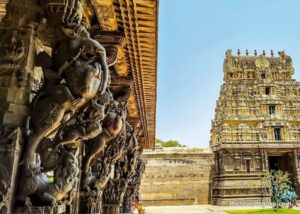GS-1-History and Culture

Context:
The Jalanatheswarar Temple, an architectural and religious landmark from the Chola era, is facing serious structural damage. The temple has not undergone Kumbhabhishekam (a vital Hindu temple consecration ritual) for over 15 years, raising concerns about its preservation.
Significance of Kumbhabhishekam
- Kumbhabhishekam is a ritual performed in Hindu temples to restore spiritual energy by pouring sanctified water over the deity, reinforcing its divine essence.
About the Jalanatheswarar Temple
- Location: Found in Thakkolam village, Ranipet district, Tamil Nadu.
- Deity: Dedicated to Lord Shiva, worshipped in the form of Jalanatheswarar (Prithvi Lingam, a lingam made of sand). His consort is Goddess Giriraja Kannikambal.
- Construction History: Initially constructed by the Pallavas in the 6th century, later expanded by the Cholas. The current masonry structure dates back to the 16th century Nayak period.
- Architectural Highlights: Features include a three-tiered gopuram, granite enclosures, and a dry temple tank.
- Religious Importance: Recognized as one of the 275 Paadal Petra Sthalams, the temple has been eulogized in the Tevaram hymns by Tamil Saivite Nayanars.
Understanding Paadal Petra Sthalams and Vaippu Sthalams
- Paadal Petra Sthalam: These temples are mentioned in the Tevaram hymns composed by Tamil Shaivite saints.
- Vaippu Sthalam: Unlike Paadal Petra Sthalams, these are temples that are casually referenced in Tamil devotional literature rather than being the primary focus.
Historical Significance of Thakkolam
- Ancient Names: Previously referred to as Thiruvural, as cited in Saivite hymns. Under Pallava rule, it was called Aparajita-Chaturvedimangalam.
- Chola Influence: During the reign of Chalukya King Vimaladitya, who was married to Kundavai (daughter of Rajaraja Chola), the town was renamed Thakkolamana Thiruvuralpuram.
- Battle of Thakkolam (949 CE): A key battle where Rajaditya Chola, son of Parantaka Chola, was defeated and killed by the Rashtrakutas.
- Epigraphic Records: The temple houses 51 inscriptions documenting land donations, temple endowments, and gold offerings. These inscriptions reference notable figures, including Pallava king Aparajita and Chola rulers.
- Rajakesari Inscription: This record highlights a solar eclipse in 894-895 CE, confirming that Aditya I ruled from 870-907 CE.
- The issue extends beyond religion, holding geopolitical significance that influences India-China relations, global Buddhist communities, and broader human rights discussions.




